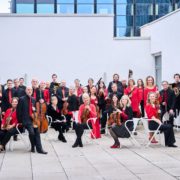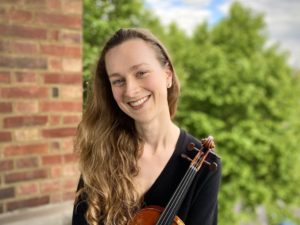Flynn Le Brocq to step down as Chief Executive of LMP
Today, we announce that Flynn Le Brocq will be stepping down as our Chief Executive at the end of August 2025. Flynn has accepted an exciting new position as Director of Admissions at Uppingham School where he will continue to inspire and lead in a new capacity with a return to the education sector.
“It has been an absolute privilege to lead this wonderful orchestra. LMP’s culture is truly special and that is down to the incredible versatility and creativity of both our players and management team. Whether it has been building snow machines, taking the orchestra overseas, putting an organ in a shopping centre, sending GoPros inside instruments or pushing the boundaries of what it means to be an orchestra in the 21st century, LMP is able to turn its hand to almost anything.
I’m immensely proud of the collaborations and the artistic partnerships we’ve built, and I feel confident about the future of this extraordinary organisation. While I may be stepping away from my role as CEO, I’ll still keep in touch with LMP from the sidelines – you might even spot me raising a glass of wine at a Tasting Notes event soon.”
– Flynn Le Brocq, Chief Executive
“We are incredibly grateful for the significant impact Flynn has had during his time with LMP. His leadership has been instrumental in securing the orchestra’s financial future, streamlining its governance, and pushing us to reach ambitious goals. Thanks to his dedication and tireless work, LMP is well positioned for the future. While we are sad to see him leave, we are excited for what lies ahead for him and have no doubt he will excel in his next role.”
– Sir Robert Lechler, Chair of LMP Board
Since joining LMP in 2021, Flynn has been a transformative force, guiding LMP through a period of artistic innovation, community engagement and organisational growth. Building on the orchestra’s distinguished 76-year history, Flynn has continued to combine legacy with evolution.
Oratorio of Hope, the opening event for Croydon’s term as London Borough of Culture in 2023, pushed the orchestra’s artistic boundaries, creating a multi-genre spectacular that was later shortlisted for a prestigious Royal Philharmonic Society Award.
The following year, in celebration of our 75th anniversary, the orchestra launched 100 Faces of Croydon – a community-led photography and music project that reflected the diversity and spirit of Croydon, reinforcing our 35-year legacy as the borough’s Resident Orchestra.
“While naturally I’m sad that Flynn is leaving, the resounding feeling I have is one of immense gratitude. Flynn has led LMP with great vision, passion and agility. The collaborative spirit which has defined our work together will no doubt continue as one of his many legacies as CEO, and I’m sure will afford him great success in his next exciting venture. I look forward to fulfilling the many shared goals we have created together, and am excited at what is next to come here at LMP.”
– Jonathan Bloxham, Conductor in Residence and Artistic Advisor
“Flynn works tirelessly to promote the voices of the players, putting us at the heart of LMP. His door is always open and no problem is too small. Flynn’s infectious enthusiasm has created a team that champions its orchestra, resulting in an organisation where players and management can unite in their vision. Working with Flynn has been a pure joy. His energy, charisma and good humour will be deeply missed.”
– Jessica Coleman, Chair of the LMP Player Committee
Flynn’s time at LMP also saw the launch Tasting Notes in 2022, an innovative musical wine tasting experience that quickly became one of our most popular offerings. Under his leadership, we have forged new relationships with promoters and agents, enabling a return to international touring and the creation of a growing network of supporters in the United States – the American Friends of LMP.
“Flynn has made an enormous impact in his time at LMP. With his boundless energy, his enthusiasm, his creativity, his clear thinking and his sound instincts, he has become someone we can trust and feel confident in at all times. He has led from the front and been an inspiration to those around him. We’ll miss him enormously, but wish him all the very best in his new life.”
– Simon Blendis, LMP Leader
“Flynn has an incredible way of making everyone feel valued, respected and supported. He has done so much for LMP with his positive energy, enthusiasm and passion. I think he has made us feel that anything is possible and we should reach for the stars. He will be hugely missed.”
– Ruth Rogers, LMP Leader
We look forward to continuing the journey Flynn helped shape and wish him every success in this exciting new chapter
A full search for a new Chief Executive will commence shortly.

















